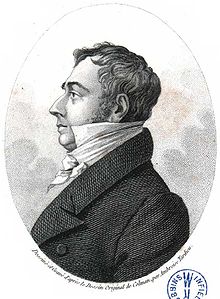Jean Vincent Félix Lamouroux (3 May 1779 – 26 March 1825) was a French biologist and naturalist, noted for his seminal work with algae.
Jean Vincent Félix Lamouroux | |
|---|---|
 Jean Vincent Félix Lamouroux | |
| Born | May 3, 1779 Agen |
| Died | March 26, 1825 (aged 45) Caen |
| Nationality | French |
| Education | Saint-Amans school |
| Known for | Seminal work with algae |
| Scientific career | |
| Fields | Biology |
| Thesis | (1805) |
| Notable students | Arcisse de Caumont |
| Author abbrev. (botany) | J.V.Lamour. |
Biography
Lamouroux was born in Agen in the Aquitaine of southwestern France, the son of Claude Lamouroux, an intellectual who made his livelihood in manufacturing, but who was also a musician, a one-term mayor of Agen, and a co-founder of the Academic Society of Agen. Jean Vincent Lamouroux studied botany at the Boudon de Saint-Amans school in Agen.
Lamouroux was particularly interested in marine organisms such as algae and hydrozoans. In 1805 he published a dissertation on several species of Fucus[1] before settling in Paris in 1807, after his father went into bankruptcy.
In 1807, Lamouroux was appointed to the French Academy of Sciences and in 1808 he became an assistant professor of natural history at the University of Caen, rising to full professorship by 1811. He joined the Linnean Society of Calvados and contributed to its publications, collaborating with his friend Jean Baptiste Bory de Saint-Vincent. About this time he became director of the Caen Botanical Gardens. He contributed articles to the journal Annales générales des sciences physiques ("General Annals of the Physical Sciences")[2] and to the Dictionnaire classique d'histoire naturelle (Classic Dictionary of Natural History).[3]
Lamouroux was the first to make the distinction between green algae, brown algae and red algae. In 1813, Dawson Turner adopted Lamouroux's classification system for algae, providing it with international credence.
Lamouroux was also interested in other classification systems in marine biology. On which he published two notable works:
- Histoire des Polypiers coralligènes flexibles, vulgairement nommés Zoophytes (Origin of the flexible coralline polypbearers, popularly named zoophytes) (1816) Caen
- Exposition méthodique des genres de l'ordre des polypiers (Systematic description of the genera of the order of polypbearers) (1821) Paris.
In 1821 he published a "Résumé d’un cours élémentaire de géographie physique" ("Summary of a basic course of physical geography")[4] exploring the foundations of atmospheric science, hydrography, astronomy, and geology. Lamouroux's interest in fossils was quite broad. He collected reptilian fossils in the Jurassic of Normandy and communicated some of them to Georges Cuvier.
In 1825, Lamouroux died in Caen. He was most influential on his student Arcisse de Caumont, who succeeded him in his chair at the University of Caen.
Species
Among the species that Lamouroux identified and described are:
|
|
|
He also described genera such as Desmarestia.[6]
In 1818, botanist Carl Sigismund Kunth described a genus of plants from Mexico and Central America, (in the family Orobanchaceae), as Lamourouxia in his honour.[7]
Notes
Sources
External links
Wikiwand in your browser!
Seamless Wikipedia browsing. On steroids.
Every time you click a link to Wikipedia, Wiktionary or Wikiquote in your browser's search results, it will show the modern Wikiwand interface.
Wikiwand extension is a five stars, simple, with minimum permission required to keep your browsing private, safe and transparent.
